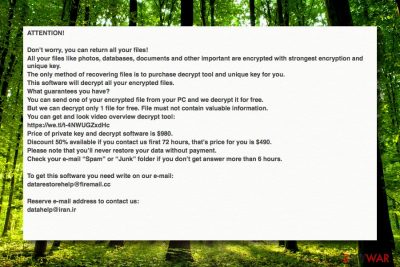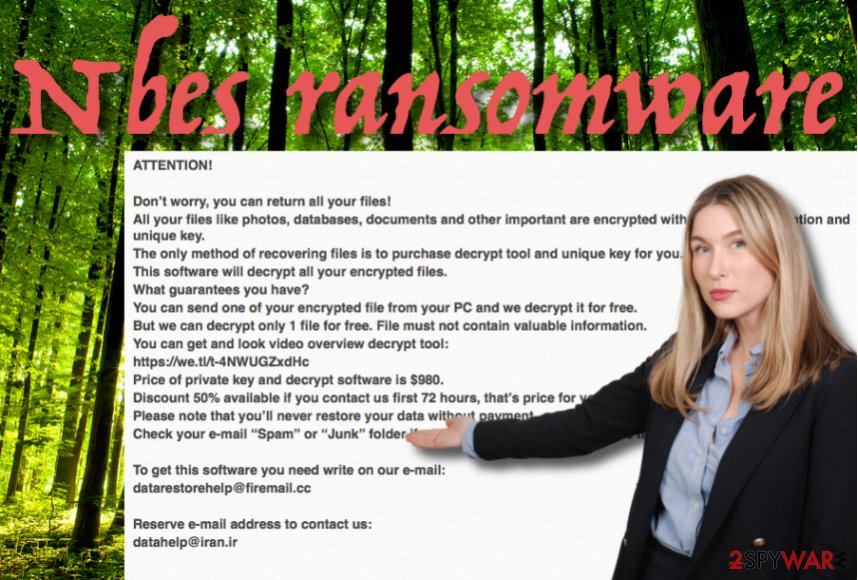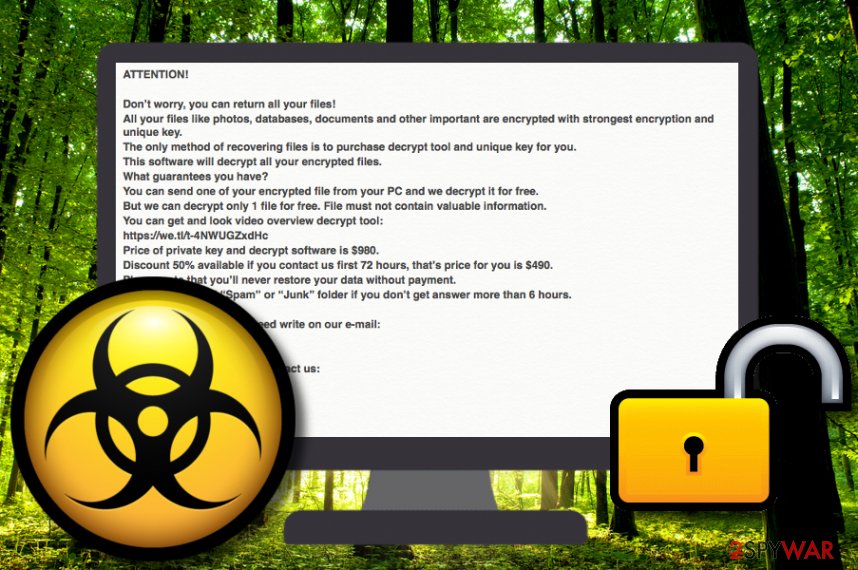Nbes ransomware (Decryption Methods Included) - Virus Removal Guide
Nbes virus Removal Guide
What is Nbes ransomware?
Nbes ransomware – a Djvu ransomware version that offers to send one small file for free decryption

Nbes ransomware is a dangerous parasite that encrypts data by adding the .nbes appendix and urges a Bitcoin ransom. The notorious malware travels via software cracks or email spam and infiltrates Windows computers unknowingly. Afterward, .nbes files virus launches an encryption module and targets all data found. This type of activity leads to ransom demands that vary from $490 to $980 and are placed in the _readme.txt message. Here crooks offer to decrypt one small file for free to give some proof of the decryption key's existence. Datarestorehelp@firemail.cc and datahelp@iran.ir email addresses are also included in the ransom message as a way to make contact.
| Name | Nbes ransomware |
|---|---|
| Category | Ransomware virus/file-locking threat |
| Family | Djvu/STOP ransomware |
| Appendix | Once files are locked by using a unique cipher, the .nbes appendix is added to each filename |
| Ransom note | This malware provides the _readme.txt ransom message that is the typical information note of all Djvu ransomware variants |
| Ransom price | At first, the criminals urge for $490 in exchange for the decryption tool. However, these people threaten to raise the price up to 50% if the victims do not transfer the money in BTC within 3 days |
| Crooks' emails | Datarestorehelp@firemail.cc and datahelp@iran.ir are written in the ransom note as a way to make contact with the cybercriminals |
| Malware spread | All STOP ransomware variants are known for distributing the AZORult Trojan virus and Nbes ransomware is not an exception |
| Elimination | You should perform the malware removal automatically as manual elimination might bring additional damage or you might accidentally miss some infectious objects while dealing with the parasite on your own |
| Fix | If the malware has managed to damage some system objects, you can try repairing your computer with software such as FortectIntego |
Nbes ransomware has already been discussed in forums and users have been urging for help on the data recovery process.[1] This malicious string appears to be a newly-released version of Djvu/STOP ransomware that has been loading the cybersphere with numerous new file-locking virus variants that currently remain undecryptable.
Nbes virus is a malicious cyber threat that can make numerous alterings to the Windows Registry, Task Manager, PowerShell, and other computer sectors. Here, the virtual parasite includes various modules some of which might be:
- Running encryption on all data files found.
- Searching for possibly encryptable components in certain time periods.
- Eliminating files' Shadow Volume Copies.
- Disabling antimalware protection.
- Automatically launching the parasite within each computer startup process.
- Damaging the hosts files to prevent users from accessing security-related sources on the web.
- Running other malicious processes in the background (e.g. malware installation).

As you can see, Nbes ransomware is capable of an entire variety of bogus and malicious activities. Nevertheless, it can infiltration additional malicious components so you might get two viruses instead of one! For example, there is a big chance that you will receive AZORult Trojan virus as STOP ransomware is known to spread this parasite actively.
Continuously, Nbes ransomware aims to urge for a big sum of money in exchange for the decryption software. At first, criminals ask for $490 and threaten to double the price if the demands are not met within 3 days of time. These people also outline that the only way to recover locked data is by purchasing the key from them:
ATTENTION!
Don’t worry, you can return all your files!
All your files like photos, databases, documents and other important are encrypted with strongest encryption and unique key.
The only method of recovering files is to purchase decrypt tool and unique key for you.
This software will decrypt all your encrypted files.
What guarantees you have?
You can send one of your encrypted file from your PC and we decrypt it for free.
But we can decrypt only 1 file for free. File must not contain valuable information.
You can get and look video overview decrypt tool:
https://we.tl/t-4NWUGZxdHc
Price of private key and decrypt software is $980.
Discount 50% available if you contact us first 72 hours, that’s price for you is $490.
Please note that you’ll never restore your data without payment.
Check your e-mail “Spam” or “Junk” folder if you don’t get answer more than 6 hours.To get this software you need write on our e-mail:
datarestorehelp@firemail.ccReserve e-mail address to contact us:
datahelp@iran.ir
We recommend denying all the demands that come provided by Nbes ransomware as there is a big risk of getting scammed by the hackers. The criminals urge for a ransom price in Bitcoin to not get tracked and stay anonymous all the time. If these people run away with your money, there are almost no chances that you will receive it back.
Nbes ransomware can bring harm to the user's files, software, and computer system. If you are looking for a tool to repair the machine, you can try using FortectIntego but remember that you need to deactivate and eliminate the cyber threat first as if its module is still running, all the malicious processes might reoccur very easily again.
For Nbes ransomware removal, we recommend employing only automatical software as manual elimination is not the technique you should be using in this case. Additionally, take a look at the end of this article where you will find computer boot options that can help you to disable malicious activities on your Windows computer.
Continuously, when you remove Nbes ransomware, do not forget to delete the Windows hosts file, otherwise, access to security-related websites will remain blocked. When the virtual parasite is finally gone, you can start thinking about data recovery possibilities. As we have already mentioned, there is no need to pay the ransom.

Even though Djvu ransomware variants who have been released after August this year remain currently undecryptable,[2] there are some other methods you can try for restoring your data. At the end of this page, we have provided three alternative data recovery options some of which might appear helpful if applied correctly.
Additionally, if you have found that Nbes ransomware has locked your files, you can try using DrWeb's Rescue Pack.[3] This software package includes a decryption tool for locked documents and two years of computer protection for $150. Some users have found it useful for Djvu malware versions, so you can give it a try too.
Data protection tips for the future
Since you have been infected with Nbes ransomware, you should have noticed that your valuable data lacks required protection that resulted in the encryption of all your important filed and documents. For this not to repeatedly happen in the future, you need to learn how to secure your files properly.
To avoid remote access to your important files and documents, you should purchase a portable drive (USB flash device) and store your information on that device. Remember, keep it unplugged from the computer when you are not using it, otherwise, malware might be able to reach the data that is kept connected to your PC.
Continuously, other data-securing methods include registering to a remote service such as iCloud or Dropbox. Here you will be able to transfer all your important documents but these servers are still less secure that pluggable USB drives.
Know about ransomware distribution
To properly protect your computer system and avoid ransomware infections, you have to know how they are spread first. According to technology specialists from Virusai.lt,[4] these cyber threats are often loaded as cracked software. You should not download any products that are provided on illegitimate sources such as The Pirate Bay. Get all of your products and services only from the official developers and their original websites.
Continuously, email spamming is another factor that can relate to secret ransomware infiltration. Crooks pretend to come from reliable shipping companies such as FedEx/DHL or trustworthy healthcare, banking organizations in order to give the email messages a look of trust. Afterward, the criminals include an infectious hyperlink or attachments that are presented as some type of important information when truly malware is hidden there.
A piece of advice would be to carefully manage all of your email letters, especially those that you receive in your Spam section. Always identify the sender, check the entire text for grammar mistakes as reputable organizations would not let themselves to deliver you an email full of mistakes. Additionally, do not open any unknown attachments without scanning them with an antivirus program that can easily detect malware in such sources.
Nbes ransomware removal possibilities
Nbes ransomware removal requires cleaning all infected directories on the Windows computer and eliminating all malicious processes at once. If you want to learn how to disable malicious tasks on your machine, you can take a look down below and will find out how to boot in Safe Mode with Networking and activate System Restore.
Afterward, you should go ahead and remove Nbes ransomware without any hesitation. The malware can be eliminated only automatically in this case as manual removal might more damage to your machine. Additionally, try using SpyHunter 5Combo Cleaner and Malwarebytes for discovering malicious objects in your computer and try employing FortectIntego that might help you to repair the damage.
When Nbes ransomware is gone, you can start thinking about file recovery purposes. As we have already mentioned, you are not advised to pay the ransom price as you might get easily scammed. As an alternative, go to the end of this article and try some of the methods that are provided there.
Getting rid of Nbes virus. Follow these steps
Manual removal using Safe Mode
To deactivate malicious processes on your Windows computer system, you have to boot in Safe Mode with Networking. Achieve such goal by completing the following tasks:
Important! →
Manual removal guide might be too complicated for regular computer users. It requires advanced IT knowledge to be performed correctly (if vital system files are removed or damaged, it might result in full Windows compromise), and it also might take hours to complete. Therefore, we highly advise using the automatic method provided above instead.
Step 1. Access Safe Mode with Networking
Manual malware removal should be best performed in the Safe Mode environment.
Windows 7 / Vista / XP
- Click Start > Shutdown > Restart > OK.
- When your computer becomes active, start pressing F8 button (if that does not work, try F2, F12, Del, etc. – it all depends on your motherboard model) multiple times until you see the Advanced Boot Options window.
- Select Safe Mode with Networking from the list.

Windows 10 / Windows 8
- Right-click on Start button and select Settings.

- Scroll down to pick Update & Security.

- On the left side of the window, pick Recovery.
- Now scroll down to find Advanced Startup section.
- Click Restart now.

- Select Troubleshoot.

- Go to Advanced options.

- Select Startup Settings.

- Press Restart.
- Now press 5 or click 5) Enable Safe Mode with Networking.

Step 2. Shut down suspicious processes
Windows Task Manager is a useful tool that shows all the processes running in the background. If malware is running a process, you need to shut it down:
- Press Ctrl + Shift + Esc on your keyboard to open Windows Task Manager.
- Click on More details.

- Scroll down to Background processes section, and look for anything suspicious.
- Right-click and select Open file location.

- Go back to the process, right-click and pick End Task.

- Delete the contents of the malicious folder.
Step 3. Check program Startup
- Press Ctrl + Shift + Esc on your keyboard to open Windows Task Manager.
- Go to Startup tab.
- Right-click on the suspicious program and pick Disable.

Step 4. Delete virus files
Malware-related files can be found in various places within your computer. Here are instructions that could help you find them:
- Type in Disk Cleanup in Windows search and press Enter.

- Select the drive you want to clean (C: is your main drive by default and is likely to be the one that has malicious files in).
- Scroll through the Files to delete list and select the following:
Temporary Internet Files
Downloads
Recycle Bin
Temporary files - Pick Clean up system files.

- You can also look for other malicious files hidden in the following folders (type these entries in Windows Search and press Enter):
%AppData%
%LocalAppData%
%ProgramData%
%WinDir%
After you are finished, reboot the PC in normal mode.
Remove Nbes using System Restore
To disable malware-laden activities on your machine, opt for the System Restore feature. You can complete this task by opting for the following guiding steps:
-
Step 1: Reboot your computer to Safe Mode with Command Prompt
Windows 7 / Vista / XP- Click Start → Shutdown → Restart → OK.
- When your computer becomes active, start pressing F8 multiple times until you see the Advanced Boot Options window.
-
Select Command Prompt from the list

Windows 10 / Windows 8- Press the Power button at the Windows login screen. Now press and hold Shift, which is on your keyboard, and click Restart..
- Now select Troubleshoot → Advanced options → Startup Settings and finally press Restart.
-
Once your computer becomes active, select Enable Safe Mode with Command Prompt in Startup Settings window.

-
Step 2: Restore your system files and settings
-
Once the Command Prompt window shows up, enter cd restore and click Enter.

-
Now type rstrui.exe and press Enter again..

-
When a new window shows up, click Next and select your restore point that is prior the infiltration of Nbes. After doing that, click Next.


-
Now click Yes to start system restore.

-
Once the Command Prompt window shows up, enter cd restore and click Enter.
Bonus: Recover your data
Guide which is presented above is supposed to help you remove Nbes from your computer. To recover your encrypted files, we recommend using a detailed guide prepared by 2-spyware.com security experts.If your files are encrypted by Nbes, you can use several methods to restore them:
Use Data Recovery Pro and recover some individual files:
If the ransomware virus has managed to lock, corrupt, or damage some of your data components, you can try repairing them with a tool like this one.
- Download Data Recovery Pro;
- Follow the steps of Data Recovery Setup and install the program on your computer;
- Launch it and scan your computer for files encrypted by Nbes ransomware;
- Restore them.
Try employing Windows Previous Versions feature for data restoring purposes:
If you have enabled the System Restore feature in the past, this method might bring you positive results.
- Find an encrypted file you need to restore and right-click on it;
- Select “Properties” and go to “Previous versions” tab;
- Here, check each of available copies of the file in “Folder versions”. You should select the version you want to recover and click “Restore”.
Use Shadow Explorer for recovering some encrypted data:
You can try this method for restoring some files that have been touched by the ransomware virus. However, keep in mind that this technique might not work if the ransomware virus managed to erase Shadow Copies of encrypted data.
- Download Shadow Explorer (http://shadowexplorer.com/);
- Follow a Shadow Explorer Setup Wizard and install this application on your computer;
- Launch the program and go through the drop down menu on the top left corner to select the disk of your encrypted data. Check what folders are there;
- Right-click on the folder you want to restore and select “Export”. You can also select where you want it to be stored.
Currenlty, no official decryption key has been released for Nbes ransomware virus.
Finally, you should always think about the protection of crypto-ransomwares. In order to protect your computer from Nbes and other ransomwares, use a reputable anti-spyware, such as FortectIntego, SpyHunter 5Combo Cleaner or Malwarebytes
How to prevent from getting ransomware
Choose a proper web browser and improve your safety with a VPN tool
Online spying has got momentum in recent years and people are getting more and more interested in how to protect their privacy online. One of the basic means to add a layer of security – choose the most private and secure web browser. Although web browsers can't grant full privacy protection and security, some of them are much better at sandboxing, HTTPS upgrading, active content blocking, tracking blocking, phishing protection, and similar privacy-oriented features. However, if you want true anonymity, we suggest you employ a powerful Private Internet Access VPN – it can encrypt all the traffic that comes and goes out of your computer, preventing tracking completely.
Lost your files? Use data recovery software
While some files located on any computer are replaceable or useless, others can be extremely valuable. Family photos, work documents, school projects – these are types of files that we don't want to lose. Unfortunately, there are many ways how unexpected data loss can occur: power cuts, Blue Screen of Death errors, hardware failures, crypto-malware attack, or even accidental deletion.
To ensure that all the files remain intact, you should prepare regular data backups. You can choose cloud-based or physical copies you could restore from later in case of a disaster. If your backups were lost as well or you never bothered to prepare any, Data Recovery Pro can be your only hope to retrieve your invaluable files.
- ^ Rohith. .NBES extension ransomware. Emsisoft Support. Topic.
- ^ Emsisoft Decryptor for STOP Djvu. Emsisoft. Decryption Tools.
- ^ Dr.Web Rescue Pack. Dr Web Products.
- ^ Virusai.lt. Virusai. Security and spyware news.





















